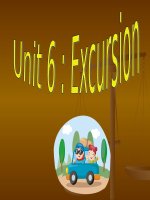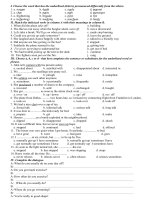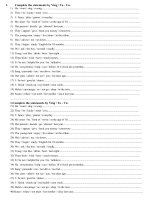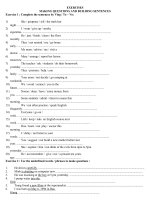LESSON PLAN UNIT 11 ENGLISH 10 national parks lesson: reading
Bạn đang xem bản rút gọn của tài liệu. Xem và tải ngay bản đầy đủ của tài liệu tại đây (130.07 KB, 14 trang )
ENGLISH 10
UNIT11: NATIONAL PARKS
LESSON: READING
Clas
s
I.
Teaching
Teacher
Absentees
date
OBJECTIVES
By the end of the lesson, students are able to
-
-
understand and know more about some national parks in the world
as well as Vietnam.
guess the meaning of words based on contexts.
scan for specific information about national parks.
share ideas about their favorite national parks( through speaking
acitvity).
II.
ANTICIPATED PROBLEMS
PROBLEMS
SOLUTIONS
Ss may have difficuties in
identifying the suitable words to
match with the expressions in
matching exercise.
T asks them to read the
passage carefully to skim the
detailed information and
perhaps T should give one
example.
Ss might not be able to
brainstorm ideas for speaking
activity.
T can give them some cues and
call one S to do a model.
Ss are probably isolated to
speak and give their opinions
T can call a S to talk. If he
cannot speak, T may asks some
simple questions
III.
IV.
Stage
MATERIALS:
Blackboard, textbook, chalk , projector, A4 papers.
PROCEDURE
Time
Activities
Interaction
Pre-reading
15mins
Lead-in: Answer questions in groups.
•
•
T asks a question: Have you ever been to a national park?
to lead in the topic: National Park
T calls a student to answer the question.
Expected answer:
Yes, I have been to Cuc Phuong Naional Park in Ninh Binh/ Tam Dao
National Park in Vinh Phuc.
Pre-reading;
•
T asks Ss to work in groups of 3 to discuss and anwer the questions
1. Can you name some of the national parks in VN & in the world?
2.What trees and animals can you see in a national park?
- Ss form groups of four and answer the questions given on the screen
within 3 minutes.
- T goes around the class and provides help if the Ss are in stuck.
- After finishing, T calls randomly a representative from each group to give
their ideas.
- Ss perform their answer and they are encouraged to add ideas to other
groups’ answers.
Suggested answer:
1.
They are Ba Vi National Park in Ha Tay, Bach Ma National Park in
Hue, Tam Dao National Park in Vinh Phuc, Nairobi National Park in
2.
Kenya and so on.
We can see a lot of trees such as pine trees, ferm-palms, and
animals for example, monkeys, lizards, bears, and so forth.
Vocabulary
- To be located in: to be in a particular place ( definition)
- Establish (v): set up( synonym)
- Rainforest (n): forest in the tropical region (picture)
- Orphan(n): a child without parents, an animal without mother.
( situation)
T: A child lives alone and does not have parents. What is he? Tell me the
word in Vietnamese?
+ Orphan (v): to make sb an orphan
+ Orphanage (n): home for orphans
- Toxic( adj): inolving sth poisonous( example)
- hike (v): to go for a long walk in the countryside
- After teaching vocabulary, T asks Ss to play a game in pairs.
- T offers a diagram showing the new words on the screen and require
each pair to remember the position of each word. ( 5 words)
- Ss are provided a piece of paper containing the diagram with five
blanks and fill in.
- Each group tries to do the quiz as fast as possible. The quickest group
is winner and will receive a gift from T.
orphanage
establish
toxic
hike
rainforest
T<=>SS
SS<=>SS
20mins
While-reading
TASK 1:
T<=>SS
MATCHING
SS<=>SS
-
T divides
the class
into 4
groups.
Each
group will
receive a
piece of
paper
containing
the content
-
of task 1.
Ss work in
4 groups to
complete
-
the task.
T goes
around the
T<=>SS
SS<=>SS
class to
observe
and have
the
-
students.
After
finishing,
groups
exchange
their
papers to
check
together.
Suggested
answer:
1.establish
4. survival
2. contain
5. sub- tropical
T<=>SS
SS<=>SS
3. species
6. contamination
TASK 2:
COMPREHENSI
ON
QUESTIONS
•
T asks Ss
to work in
pairs to
answer the
questions
given in
the
courseboo
•
k.
Ss work in
pairs to do
T<=>SS
SS<=>SS
•
the task.
T goes
around the
class to
help some
•
weak Ss.
Ss are
encourage
d to check
and
compare
the answer
before T
gives
feedback.
Expected
answer:
1. The area of
the rainforest in
Cuc Phuong
T<=>SS
SS<=>SS
National Park/ It
is over 200
square km.
2. Because the
rainy season is
over.
3 They can
learn anout the
habits of animals
and how one
specises is
dependent upon
another for
survival.
4 In the
Orphanage
and /or
abandoned
animals are
T<=>SS
SS<=>SS
taken care of.
5. Everglades
National Park is
endangered
because the
toxic levels of
chemicals in the
water.
6. If more
chemicals are
released into the
water, plants and
animals will die/
be killed/
destroyed.
TASK 3:
COMPLETE
THE TABLE( If
have time)
T<=>SS
SS<=>SS
-
T asks Ss
to work
individually
and
complete
the table in
-
the book.
Ss are
required to
work
individually
, then
compare
their
-
answers.
After
finishing,
Ss write
the words
they guess
T<=>SS
SS<=>SS
on the
board.
Expected
answer:
T<=>SS
SS<=>SS
Cuc
Phuong
National
Park
-Located
160
kilometres
south
west
of
Ha Noi.
-The
activities
tourists
can do
there:
+ study
butterflies
+visit
caves
+hike
mountains
+ look at
the 1,000
year-oldtree
Nairobi
National
Park
Everglade
s National
Park
- The
smallest
park in
Kenya.
-The
things
visitors
can learn
there:
+ how to
recognize
the
different
species of
animals
and plants
+ the
habits of
animals &
how one
species is
dependent
upon
another
for
survival.
It is a
subtropical
wilderness
in
southeast
ern
United
States.
- Special
features
we can
see there:
+ tropical
&
temperate
zones.
+ the toxic
levels of
chemicals
in the
water
plants &
animals
from both
T<=>SS
Post-reading
SS<=>SS
10mins
-
T asks Ss
to work in
pairs to
discuss
and
answer the
-
questions.
Ss work in
pairs to
deal with
the
questions.
Expected
answers:
•
Which of
the three
national
parks
would you
SS<=>SS
T<=>SS
SS<=>SS
like to visit
most?
Why?
Reasons for
visiting Cuc
phuong
National
Park:
•
to look at
the 1,000
year- old
•
tree.
to study
•
butterflies.
to visit
caves( Wo
uld it be
dangerous
•
to do so?)
to hike
T<=>SS
SS<=>SS
mountains.
Reasons for
visiting
Nairobi
National
Park:
•
to learn
how to
recognise
the
different
species of
animals
•
and plants.
to learn
about the
habits of
animals
and their
T<=>SS
SS<=>SS
dependenc
e on one
•
another.
to visit the
orphannag
e and see
how the
orphaned
and
abandoned
animals
are looked
after.
Reason for
visiting
Everglades
National park:
•
to see the
plants and
T<=>SS
SS<=>SS
animals
from both
tropical
and
temperate
•
zones.
to see the
wildlife of
the
southeaste
rn United
•
States.
to know
how toxic
chemicals
in water
can affect
the park
and
animals in
T<=>SS
SS<=>SS
-
it.
After
finishing
discussion,
T asks
some pairs
to make a
conservati
on to share
about their
favorite
national
parks.
Extra activity:
-
Ss are
required to
rewrite the
text as an
advertisem
T<=>SS
SS<=>SS
-
ent.
T guides
the Ss
using the
reading
context.
Homework :
-
Review the
new
-
words.
Do
exercise in
the
-
workbook.
Prepare for
the
speaking
lesson.









